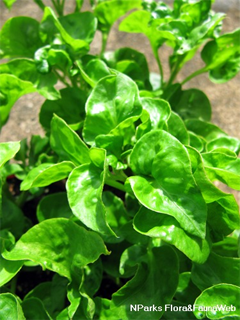
Brazilian Spinach, Sambu, Samba lettuce
Latin Name: Alternanthera sissoo
USDA Hardiness: 10-12
Native Range: TEMPERATE ASIA: an island in Indonesia), Assam, Bangladesh, Borneo, Cambodia, India, Indonesia), Iran, Iraq, Japan), Japan), Jawa (Java, Laccadive Islands, Laos, Lebanon-Syria, Malaya (Peninsular Malaysia), Maluku (Moluccas, Myanmar (Burma), Nansei-shoto (Ryukyu Islands, Nepal, New Guinea, Ogasawara-shoto (Bonin Islands, Pakistan, Philippines, Taiwan, Thailand, Vietnam, West Himalaya, Yemen,Andaman Islands. NORTHERN AMERICA: Belize, Cayman Islands, Costa Rica, Cuba, Dominican Republic, El Salvador, Guatemala, Haiti, Honduras, Jamaica, Mexico Gulf, Mexico Northeast, Mexico Southeast, Mexico Southwest, Nicaragua, Panama, Puerto Rico, Trinidad-Tobago, Venezuela, SOUTHERN AMERICA: Bolivia, Brazil North, Brazil Northeast, Brazil South, Brazil Southeast, Brazil West-Central, Colombia, French Guiana, Guyana, Paraguay, Peru, Suriname, AUSTRALASIA: New South Wales (Australia), Northern Territory (Australia), Solomon Islands, Western Australia
Edibility Rating: 4 / 5
Medicinal Rating: 0 / 5
Region:
Family:
Plant Type:
Medicinal Uses
Edible Uses
Edible Parts: Leaves Shoots | Edible Uses: Leaves - cooked and used as a spinach[ 298 ]. The shoots are harvested when 15 - 25cm long - frequent harvesting stimulates new growth and increases overall yields[ 298 ].
Cultivation
Plants can thrive in 50% or more shade. Prefers a well-drained soil with a high organic content[ 298 ]. It is a fast-growing, spreading plant, but it does not produce seeds and is not considered to be invasive. The plant can suffer severe insect damage to the leaves in some areas[ 298 ]. Leaves can be harvested year-round, but they are typically best harvested in spring and summer when young and tender. Brazilian Spinach flowers from late summer to autumn. It can serve as ground cover, helping to prevent soil erosion and improve soil quality. Brazilian Spinach grows quickly and can reach maturity in about 3 to 4 months under favourable conditions.
Known Hazards
None known
Habitats
Not known
